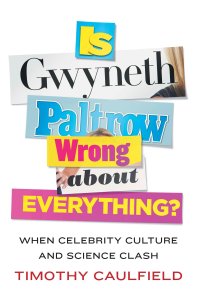
“Evidence-based entertainment” is the motto and mandate of the production team under whose banner this blog exists. It expresses a desire for subversive education in light of growing apathy, for using the tools of entertainment to foster skepticism. The pill is always easier to swallow in a scoop of ice cream.
I love stumbling upon like-minded individuals who have found creative ways of bringing real science to an indifferent audience. Law professor and author Timothy Caulfield struck the perfect balance with his first outing, The Cure for Everything! With this sophomore tome, Is Gwyneth Paltrow Wrong About Everything?, he shows us the potential longevity of a writing approach that weaves scientific results into a tapestry of funny encounters and personal experiences. I look forward to future iterations of the formula: it makes for compelling and enriching reads.
The first half of Gwyneth seems like the natural continuation of Cure: from nutrition and fitness, we move to detox cleanses, unproven cosmetics, and drastic surgeries. The lens through which these cure-alls are described is that of Hollywood celebrities, most particularly their unelected spokesperson, Gwyneth Paltrow, whose website Goop promises to be that rare place “where food, shopping, and mindfulness collide.” “In the preface [to Gwyneth Paltrow’s cookbook, It’s All Good], she credits [Dr. Alejandro Junger], and the Clean Cleanse, with curing her of a variety of ailments, including the banishment of an intestinal parasite that went undetected by Gwyneth’s conventional physicians, the adjustment of her ‘sky-high’ adrenals and the unclogging of her horribly clogged liver.” For a reader like me who knows the world of pseudomedicine and its simpler, rational counterpart, this is like shooting fish in a barrel; but to Caulfield’s credit, he integrates the bucket of cold water (“absolutely no evidence supports the idea that we need to detoxify our bodies”) amidst a page-turning narrative: he visits Goop headquarters in London; has his face scanned by two dermatologists (before and after a costly beauty routine); and even makes it to an American Idol audition. Well, sort of.
The second half of the book was more illuminating to me: putting aside what celebrities peddle, how likely is it to become one of them? We may all think we know the answer but the numbers Caulfield cite give lottery probabilities a run for their money. Chances of becoming a movie “star”: 1 in 1.5 million. Chances of a pro career in football: 0.08%. Chances of becoming a full-time independent musician who lives on an average salary: 1 in 477,000. And while you are awaiting your turn into the rock-star spotlight, you will be making, on average, 7,228$ a year, which is “less than half of the Canadian poverty line cutoff.” And yet fame is, according to a recent survey, “the number-one cultural value of children between the ages of ten and twelve”, with a depressingly high number of students believing celebrity status was within reach. The author summarizes the cognitive dissonance at play here with this gem: “People think the statistics apply to other people, but not to them.”
With so many studies quoted, some facts are bound to surprise the reader, how ever well informed he or she is. Did you know that the rural lifestyle is not all it’s cracked up to be? Life expectancy goes down as you move to the countryside. But don’t worry, because beautiful pianists play what sounds like better music compared to their uglier counterparts. The final section of the book, on whether fame is worth having, drags on a bit. After reading nearly 300 pages on celebrities, I must admit the message was clear and I couldn’t wait to move to a less glamorous subject.
Putting aside the nay-say, what positive message there is boils down to, “You aren’t going to be rich and famous. Stop worrying about it.” The lesson reminded me of the much-publicized atheist bus ad campaign of 2009: “There’s probably no god. Now stop worrying and enjoy your life.” Irrationality of all ilk thrives amidst fear-mongering. The more people worry, the likelier they will be tempted to seek out all-encompassing answers, which tend to be unscientific and complex. In both The Cure for Everything! and his latest book, Is Gwyneth Paltrow Wrong About Everything?, Timothy Caulfield beautifully reinforces the best kept secret of life: keep it simple. Eat well, exercise regularly, get a good night sleep, and accept that you will never be a celebrity. Will the message reach the people who need it most? If any messenger can make it happen, it is one whose writing is compelling, disarming, and entertaining. Gwyneth Paltrow may not be wrong about everything, but Timothy Caulfield shows us the dangers of following the siren song of scientifically illiterate celebrities. And he makes it fun.
The Trojan horse of rationality has arrived.


